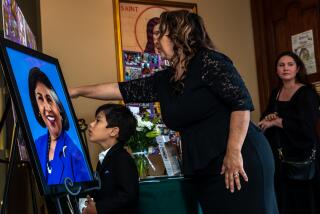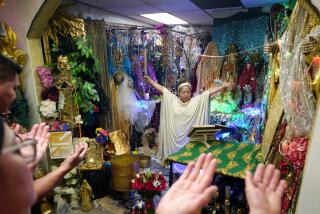Thousands in Calcutta View Body of Beloved Nun
- Share via
CALCUTTA — The body of Mother Teresa lay on a bed of ice in a humid corner of this city Saturday, as thousands of people whom she had touched with her grace came to give thanks in the hours after her death.
Rich and poor, bedraggled and well-dressed, they brought flowers, prayers and tears to the convent where the “saint of the gutters” earned a worldwide reputation for caring in a city famous for its squalor.
Cooled by ice blocks to make up for the lack of air conditioning, Mother Teresa lay in her white-and-blue frock, surrounded by the nuns she inspired. The sisters chanted and sang as the mourners walked silently by.
“She was the symbol of perfect love,” said Annie Jose, who brought her two children, Jisha and Jinu, to pay tribute. “The poorest people--people who others would not even look at--always had a place to go.”
The outpouring of emotion across Calcutta came a day after the death of the 87-year-old Roman Catholic nun, recognized around the world for her efforts to help the sick and the hungry. Leaders of the Congregation of the Missionaries of Charity, the order she founded, said they planned to move her body today to a church in an effort to accommodate all the mourners.
A funeral Mass was set for Saturday at the St. Thomas Church, but no decision had been made about a burial site.
Calcutta, a teeming, impoverished city of 11.5 million people, bore everywhere on Saturday memorials to the life of its most celebrated resident. The St. Thomas Church, where Mother Teresa first taught geography in 1929, was awash in wreaths of white lotus flowers. At the Nirmal Hriday Home for Dying Destitutes, filthy, half-naked men sat on the steps and wondered where they would get their next meal. Across town, a nighttime crowd stood quietly outside the orphanage where about 500 children have a home.
“Our Beloved Mother Went Home to Jesus,” said a poster on the wall outside the room where Mother Teresa lay.
Inside, about 50 nuns, all wearing the distinctive white, blue-trim habits that Mother Teresa made famous, chanted over the sound of whirring fans:
“For the sake of sorrow, have mercy on us.”
Sister Nirmala, who took over leadership of the Missionaries of Charity for Mother Teresa earlier this year, promised to carry on the work of the order’s founder, who won the 1979 Nobel Peace Prize.
“India has gained because Mother is in heaven,” Sister Nirmala said. “She will be praying in a very special way.”
Christians as well as Hindus, who make up a large majority of India’s population, came forth Saturday to offer prayers of support. In the streets, there was even talk of making Mother Teresa a Hindu icon.
In an hour’s span Saturday evening, Sister Nirmala received condolences from Catholic nuns, saffron-robed Hindu priests and Anglican seminary students dressed in long white smocks.
Mother Teresa’s vision, seminary student Johnson George said, transcended religious boundaries.
“We have lost the mother of India,” George declared, standing outside the convent gates.
The people trudging to Mother’s House, as the convent is known, spanned the economic spectrum as well. The wealthier and better-connected had an easier time getting past the police to see Mother Teresa, while some of the poorer people stood at the barricades outside.
“When she was here, the poor came to receive and the rich came to give,” said Karina Akhtar, who lives nearby. “Everybody loved Mother Teresa, and she loved them back.”
Whatever the efforts of Mother Teresa’s successors, those she helped made it poignantly clear Saturday that she would not be forgotten.
As the sun set on the city, a group of children and young men curled up to sleep on the steps of the Nirmal Hriday Home. Across the street--a chaotic knot of blaring horns and rattling engines--a mother with her newborn spread a sheet on the sidewalk and lay down for the night.
To Minu Ghosh, a 27-year-old who pulls a rickshaw and sleeps on the doorstep, the passing of Mother Teresa is a terrifying thing. However overburdened the hospital was, Ghosh said, the nuns always spared enough food for the people living outside.
Ghosh, whose daily earnings add up to about 50 cents, said he was worried about what would happen next.
“With Mother Teresa gone, we wonder if we will still be able to eat,” Ghosh said. “When we heard that she died, we all started to cry.”
More to Read
Sign up for Essential California
The most important California stories and recommendations in your inbox every morning.
You may occasionally receive promotional content from the Los Angeles Times.










